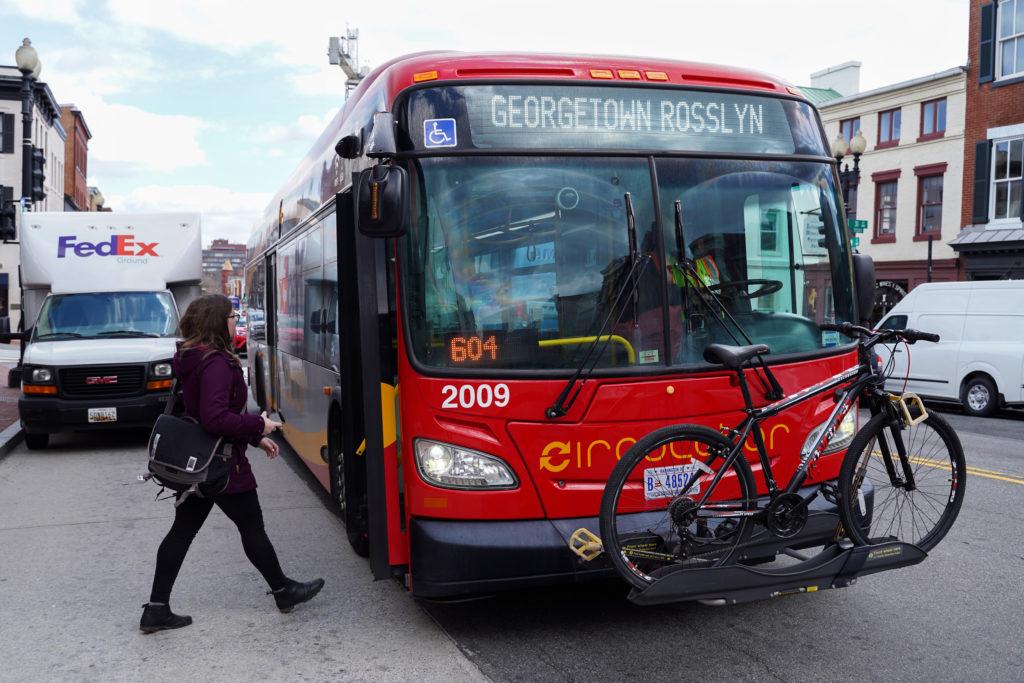Local politicians said free rides on DC Circulator buses will boost the accessibility of local transportation and make it easier to travel through Ward 2.
Mayor Muriel Bowser announced in the annual State of the District address last week that the city would nix the costs of riding the Circulator because increased transportation options give more residents “a fair shot” at accessing job opportunities in D.C. Local politicians said the free bus service would benefit residents searching for easy transportation, but experts said the District should also invest in designated bus lanes and expanded bus routes to ensure the service is effective.
The DC Circulator system has six routes primarily in downtown, tourist-heavy areas of D.C. with no routes connecting to the majority of D.C.’s east side. The Circulator’s Georgetown to Union Station and Dupont Circle to Rosslyn routes connect the Foggy Bottom and West End neighborhoods to other areas of the District and Virginia.
Bowser originally offered free DC Circulator bus rides throughout February and extended the program through the end of March. She said workers in hotels, restaurants and shops have stopped her during the past few months to show their support for the service.
“They shared how being able to get to and from work for free each day has made a real difference,” Bowser said in a press release last week. “They work hard and stretch each dollar for their families, and they’re never going to ask for a handout.”
District Department of Transportation spokesman Terry Owens said the Circulator’s operating budget is roughly $25 million a year. He said riders took 4.6 million trips between October 2017 and September 2018, producing more than $3 million in revenue.
Owens said Bowser is “committed” to increasing support of public transportation to alleviate traffic congestion. He said Bowser aims to increase the number of transit options and support “existing systems that include DC Streetcar, DC Circulator and Capital Bikeshare.”
Bowser’s fiscal year 2020 budget allocates more than $16 million to support the free bus service and expand routes to Ward 7.
Members of the West End and Foggy Bottom Advisory Neighborhood Commission said students and local residents will benefit from free bus rides since the Circulator services many areas of Ward 2, but some raised concerns over a lack of access to the transit system in lower-income wards.
Commissioner James Harnett, who is also a junior, said free rides will aid students who use the DC Circulator to travel to Georgetown because there is no Metrorail station in the neighborhood. He said the city should offer free access to public transportation in all wards, noting that Wards 4, 5 and 7 are not fully accessible via the Circulator.
“I’ll be looking to support the other ANC commissioners in Ward 7 and trying to use the privilege we have in Foggy Bottom – to already be a part of the Circulator service – to expand that to the other parts of the city,” Harnett said.
Commissioner Patrick Kennedy said Circulator routes should be expanded to lower-income areas that are heavily dependent on public transit.
“I would hope that the District seriously entertains investing an equal amount of focus on fare reductions as a pathway to equity,” Kennedy said.
Hayley Richardson, a senior communications associate at TransitCenter – a foundation that seeks to improve public transit – said free bus transit systems already exist in cities like Baltimore. She said the programs sometimes create more problems than they solve, like overcrowding and vandalism.
“There’s an argument to be made that when something is free, people don’t value it,” she said.
Richardson said the District should also invest in other transportation improvements, like designated bus lanes, to help avoid traffic.
“It’s important to think about opportunity cost,” she said. “Is it really equitable for riders to be sitting in a free bus that holds 40 people that is also sitting in the same traffic as a car that holds one person?”
DDOT will create temporary designated bus lanes on H and I streets this summer as parts of the Metro undergo renovations. Bowser, the mayor, also designated funding for two center-running bus lanes along K Street in her proposed budget for fiscal year 2020.
Alexis Perrotta, a doctoral lecturer at Baruch College who specializes in urban transportation policy, said she was “emotionally moved” by the mayor’s initiative because free rides will make transportation more accessible to people struggling financially, even though the previous $1 cost of a Circulator ride “might not seem like much.”
“It’s hard to overstate how important it is that someone might make a decision based on trying to save a dollar here and there in terms of where they go and how they get there,” she said.




